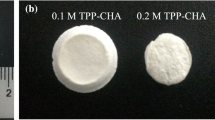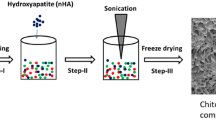Abstract
A study on the bioactivity and mechanical properties of the porous hydroxyapatite–hardystonite–PCL was performed, and the results were compared with the non-modified porous hydroxyapatite. Different apatite morphologies were observed in these two modified and unmodified scaffolds. The compression strength, modulus and toughness of the modified scaffolds showed 104, 14 and 38% improvement compared to unmodified scaffolds. This can be ascribed to the main role of thin polymer-ceramic coating layer applied on the surface of hydroxyapatite scaffolds on the mechanical and biological properties. These composite scaffolds showed a great potential to be used for bone tissue engineering application.
Access provided by Autonomous University of Puebla. Download conference paper PDF
Similar content being viewed by others
Keywords
Introduction
In tissue engineering field, many attempts have been focused on preparing highly porous scaffolds with appropriate mechanical strength and bioactivity [1, 2]. An interconnected porous structure in scaffolds can mimic architecture and function of the extracellular matrix while providing a pathway for intercellular communication and allowing the exchange of nutrient and waste and ingrowth of cell and vascular [3, 4]. Various methods including phase separation, electrospinning, space holder method, and gel casting techniques are utilized to prepare porous scaffolds for bone tissue engineering applications [5, 6]. However, these methods are restricted by morphology, interconnectivity and size of pores. Hence, using the natural bovine bone scaffolds can be new methods for designing a scaffolds near the human bone [7]. Based on the literature, hydroxyapatite (HA) is widely used for bone tissue engineering applications. Despite its excellent biological properties, HA has shown a weak mechanical property and biodegradability [8, 9]. This is the drawback of these materials which restrict its use in load-bearing applications. Therefore, combination of hydroxyapatite with silicate-based ceramics and polymer coatings has been useful for obtaining nanocomposite materials with high mechanical and biodegradability properties of scaffolds [10]. The aim of this study was fabrication of nanocomposite porous hydroxyapatite-hardystonite-PCL using natural bovine bone to take the advantage of its high mechanical and biological properties.
Material and Methods
In this study, the spongy part of bovine bone was cut to rectangular samples with 10 × 10 × 18 mm in size. First, all rectangular samples sintered at 900 ℃ for 1 h. Then, all rectangular scaffolds were coated with 0, 5, 10 and 15 wt% nanostructured hardystonite/PCL composite. Briefly, PCL polymer (10 wt%) was dissolved in 50 cc dichloromethane. Then, the nanohardystonite with 0, 5, 10 and 15 wt% was added to the solution. Then, the samples are soaked for 30 min in solution, and the samples are heated at 45 ℃ for 5 h in an oven.
To evaluate the morphology of pores, the scanning electron microscopy (SEM, Philips XL30 with acceleration voltage of 10–30 kV) coupled with energy- dispersive spectroscopy (EDS) was used. In order to evaluate the apatite formation ability, the optimum sample based on the mechanical properties was soaked in simulated body fluids (SBFs) with pH of 7.4 and at a temperature of 37 ℃. The functional groups of samples after immersion in simulated body fluid (SBF) for 21 days were evaluated by Fourier transform infrared spectroscopy (FTIR, JASCO 680 PLUS) in the range of 400–4000 cm−1. The percentage of porosity was measured using DahoMeter DE-120 M densimeter.
Results and Discussion
Table 1 shows the mechanical and physical properties of natural hydroxyapatite (NHA) scaffold compared to hydroxyapatite–hardystonite–PCL (NHA-HT-PCL) composite scaffolds with various wt% of hardystonite. The porosity of NHA, NHA-5wt%HT-PCL, NHA-10wt%HT-PCL and NHA-15wt%HT-PCL scaffolds was 95 ± 1%, 94 ± 2.5%, 91 ± 1.5% and 90 ± 1.3%, respectively. As shown, after coating the samples a decreasing trend in porosity of scaffolds was observed. Also, applying the coating resulted in an increase in the compressive strength and modulus of NHA (0.5 ± 0.1 MPa and 112. 13 ± 5.41 MPa) to 0.51 ± 0.1 MPa, 114.5 ± 4.31 MPa, 1.02 ± 0.1 MPa, 128.1 ± 5.21 MPa, 0.9 ± 0.1 and 171.12 ± 6.21 MPa for NHA-5wt%HT-PCL, NHA-10 wt%HT-PCL and NHA-15wt%HT-PCL scaffolds, respectively. Increasing the toughness is another result of applying the composite coating on the surface of natural hydroxyapatite. The optimum samples based on mechanical properties with appropriate porosity are NHA-10 wt%HT-PCL. Using scaffold with close physical and mechanical properties to human spongy bone is really important to avoid stress shielding phenomenon. As shown in this study, the mechanical properties of the optimum scaffold were in the range of the low load-bearing compressive strength of natural spongy bone (the compressive strength and modulus of natural spongy bone are in the range of 0.2–4 and 120–1000 MPa), respectively [11].
Figure 1a–c shows the SEM micrographs of NHA and NHA-10 wt% HT-PCL composite scaffolds. As shown, the interconnected micropores (in the range of 100–200 µm) and macropores (in the range of 800–1000 µm) can be observed in NHA scaffold. While applying the coating decreased the size of micropores as well as the size of macropores. As shown, applying the coating caused a soft and smooth surface without any crack on the NHA-10wt%HT-PCL composite scaffolds. A good agreement is observed between the results of SEM and mechanical properties. Figure 1b–d shows the EDS spectra of NHA scaffold compared to NHA-10wt%HT-PCL composite scaffolds. As shown, the observation of characteristic peaks of Si and Zn peaks confirmed the presence of hardystonite phases in the coating on the surface of NHA ceramic.
To evaluate the apatite formation ability of scaffolds before and after modification, the NHA scaffold and NHA-10wt%HT-PCL composite scaffolds were soaked in SBF for up to 21 days.
Figure 2a shows the SEM images of NHA scaffolds. Some white precipitates with spherical shape were observed on the surface of NHA. Applying the HT-PCL coating on the surface of scaffold resulted in the formation of a sticky layer on the entire surface of the scaffold. It seems that applying this coating led to an increase in biodegradability and bioactivity of NHA scaffold.
Figure 2c and d shows the FTIR patterns of NHA and NHA-10wt%HT-PCL composite scaffolds after 28-day soaking in SBF. The absorption peaks of OH and PO4 were observed at 635 cm−1 and 1080, 1034, 602, 571 and 874 cm−1 [12]. In Fig. 2d, the vibration bands of Si‒O‒Si and Si–O were observed in the range of 1140–910 and 500–600 cm−1 which had an overlap with PO4 group bands [13]. The characteristic peaks of Ca‒O and Zn‒O at 564 and 511 cm−1 confirmed the presence of hardystonite on the surface of scaffold [14, 15]. The new adsorption peaks related to phosphate groups were also detected at 1020, 980, 912, 689 and 614 cm−1. The presence of the carbonate groups at 1400 and 831 cm−1 showed the formation of crystalline apatite [11, 12]. The formation of CO bands at 1727 cm−1 showed the presence of PCL on the surface of NHA-10 wt% HT-PCL composite scaffolds [10].
Conclusion
In this study, we successfully fabricated the hydroxyapatite–hardystonite–PCL nanocomposite scaffolds by using the natural bovine bone. Based on the mechanical and physical properties, the optimum sample was NHA-10 wt% HT-PCL with compressive strength, modulus, toughness and porosity 1.02 ± 0.1 MPa, 128.1 ± 5.21 MPa, 0.98 ± 0.1 kJ/m3 and 91 ± 1.5%. Based on the SEM results, modifying the surface of the scaffold results in improving the apatite formation ability of scaffolds. Furthermore, applying the polymer ceramic coating on the initial scaffolds increased the mechanical strength of the samples. Modifying the hydroxyapatite scaffolds with this procedure can result in a better mechanical properties that can match with the site of implantation and prevent the failure of the scaffolds after the surgery.
References
Arifvianto B, Zhou J (2014) Fabrication of metallic biomedical scaffolds with the space holder method: a review. Mater (Basel) 7:3588–3622
Roohani-Esfahani SI, Dunstan CR, Davies B, Pearce S, Williams R, Zreiqat H (2012) Repairing a critical-sized bone defect with highly porous modified and unmodified baghdadite scaffolds. Acta Biomater 8:4162–4172
Ni S, Chang J, Chou L (2008) In vitro studies of novel CaO–SiO2–MgO system composite bioceramics. J Mater Sci Mater Med 19:359–367
Sadeghzade S, Emadi R, Labbaf S (2016) Formation mechanism of nano-hardystonite powder prepared by mechanochemical synthesis. Adv Powder Technol 27:2238–2244
Sadeghzade S, Emadi R, Ahmadi T, Tavangarian F (2019) Synthesis, characterization and strengthening mechanism of modified and unmodified porous diopside/baghdadite scaffolds. Mater Chem Phys 228:89–97
Soleymani F, Emadi R, Sadeghzade S, Tavangarian F (2019) Applying Baghdadite/PCL/Chitosan nanocomposite coating on AZ91 magnesium alloy to improve corrosion behavior. Bioactivity, Biodegradability, Coatings 9:789
Kim JY, Lee JW, Lee S-J, Park EK, Kim S-Y, Cho D-W (2007) Development of a bone scaffold using HA nanopowder and micro-stereolithography technology. Microelectron Eng 84:1762–1765
Ng AMH, Tan KK, Phang MY, Aziyati O, Tan GH, Isa MR, Aminuddin BS, Naseem M, Fauziah O, Ruszymah BHI (2008) Differential osteogenic activity of osteoprogenitor cells on HA and TCP/HA scaffold of tissue engineered bone. J Biomed Mater Res A 85:301–312
Sadeghzade S, Emadi R, Tavangarian F, Doostmohammadi A (2020) The influence of polycaporolacton fumarate coating on mechanical properties and in vitro behavior of porous diopside-hardystonite nano-composite scaffold. J Mech Behav Biomed Mater 101:103445
Joughehdoust S, Behnamghader A, Imani M, Daliri M, Doulabi AH, Jabbari E (2013) A novel foam-like silane modified alumina scaffold coated with nano-hydroxyapatite–poly (ε-caprolactone fumarate) composite layer. Ceram Int 39:209–218
Gerhardt L-C, Boccaccini AR (2010) Bioactive glass and glass-ceramic scaffolds for bone tissue engineering. Mater (Basel) 3:3867–3910
Ghomi H, Emadi R, Javanmard SH (2016) Fabrication and characterization of nanostructure diopside scaffolds using the space holder method: effect of different space holders and compaction pressures. Mater Des 91:193–200
Sadeghzade S, Emadi R, Tavangarian F, Doostmohammadi A (2020) In vitro evaluation of diopside/baghdadite bioceramic scaffolds modified by polycaprolactone fumarate polymer coating. Mater Sci Eng C 106:110176
Sadeghzade S, Emadi R, Labbaf S (2017) Hardystonite-diopside nanocomposite scaffolds for bone tissue engineering applications. Mater Chem Phys 202:95–103
Sadeghzade S, Emadi R, Tavangarian F (2016) Combustion assisted synthesis of hardystonite nanopowder. Ceram Int 42:14656–14660
Author information
Authors and Affiliations
Corresponding author
Editor information
Editors and Affiliations
Rights and permissions
Copyright information
© 2021 The Minerals, Metals & Materials Society
About this paper
Cite this paper
Tavangarian, F., Sadeghzade, S., Emadi, R. (2021). Biodegradability and Bioactivity of Porous Hydroxyapatite–Hardystonite–PCL for Using in Bone Tissue Engineering Application. In: TMS 2021 150th Annual Meeting & Exhibition Supplemental Proceedings. The Minerals, Metals & Materials Series. Springer, Cham. https://doi.org/10.1007/978-3-030-65261-6_32
Download citation
DOI: https://doi.org/10.1007/978-3-030-65261-6_32
Published:
Publisher Name: Springer, Cham
Print ISBN: 978-3-030-65260-9
Online ISBN: 978-3-030-65261-6
eBook Packages: Chemistry and Materials ScienceChemistry and Material Science (R0)






